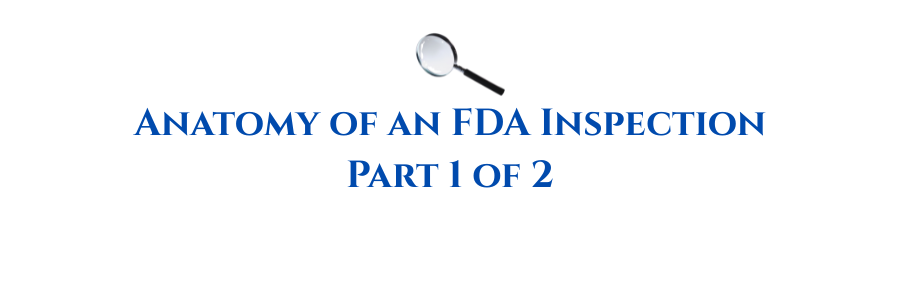Inspections are how the FDA checks that what’s promised is real:
- SAFE PRODUCTS
- SOUND PROCESSES
- PUBLIC TRUST
FDA inspections can occur for various reasons – a routine schedule, a follow-up to a prior issue, a pre-approval for a new product, or “for-cause” in response to a specific problem.
What Happens During an FDA Inspection? (And What They are Really Looking for) –
ANATOMY OF AN INSPECTION-
1) THE KNOCK – FDA Inspector arrives unannounced and present their official FDA credentials along with a Notice of Inspection (Form FDA 482) to the firm’s management with the purpose.
It is advisable that a pre-designated, knowledgeable representative of the firm (e.g. a plant or quality manager = ensures that the inspector has access to all areas and records, and that the company understands the observations being made in real time) accompany the FDA investigator at all times during the visit.
2) THE TOUR – Expect a full walkthrough. They are not sightseeing—they are assessing cleanliness, process flow, segregation, safety practices. Every corner speaks volumes.
3) THE DIG – Records matter. Investigator is auditing the firm’s quality management system against FDA requirements. SOPs, batch documents, complaint logs, CAPAs, validation data—it’s all fair game. DOCUMENTATION SHOULD TELL A STORY OF VIGILANCE, NOT JUST COMPLIANCE.
They may also collect product samples or environmental samples for analysis.
4) THE INTERVIEWS – They will speak with employees, sometimes at random. What they are probing isn’t just answers—it’s culture. They are asking: DOES THE TEAM BELIEVE IN WHAT THEY ARE DOING?
5) THE CLOSE OUT – Investigator holds a close-out meeting (exit interview) with senior management to discuss significant findings and concerns.
If objectionable conditions or potential violations were observed, the investigator will issue a written list of Inspectional Observations (FDA Form 483) and leave this with the firm’s management.
It’s not the end—it’s a chance to show leadership. OWN THE NARARATIVE, FIX THE GAPS AND COMMIT TO BETTER.
POST-INSPECTION OUTCOMES:
1) No Action Indicated (NAI): No significant violations.
2) Voluntary Action Indicated (VAI): Issues noted, but no immediate enforcement needed.
3) Official Action Indicated (OAI): Serious violations requiring FDA intervention.
If Form 483 observations are issued, the company should respond in writing—typically within 15 business days—detailing corrective actions taken or planned. This response is critical & weighs heavily in FDA’s next steps.
In cases of serious non-compliance, the FDA may escalate enforcement, including Warning Letters, recalls, or other actions.
If no major issues are found, the process ends with an Establishment Inspection Report (EIR) confirming compliance.
AN FDA INSPECTION TELLS A STORY. THE QUESTION IS: BE ONE OF CONTROL, CONSISTENCY & CARE—OR CONFUSION, CORNER-CUTTING & CHAOS?
Read also: Anatomy of an FDA Inspection | Part 2 of 2
Resource Person: Bharathi Kodali

